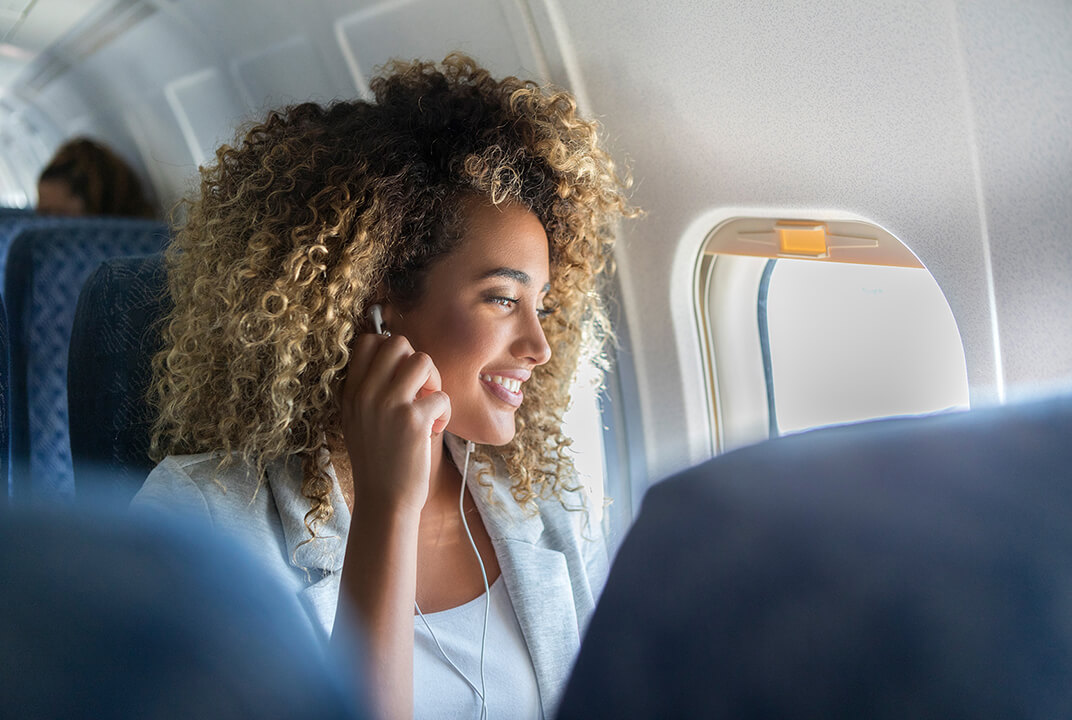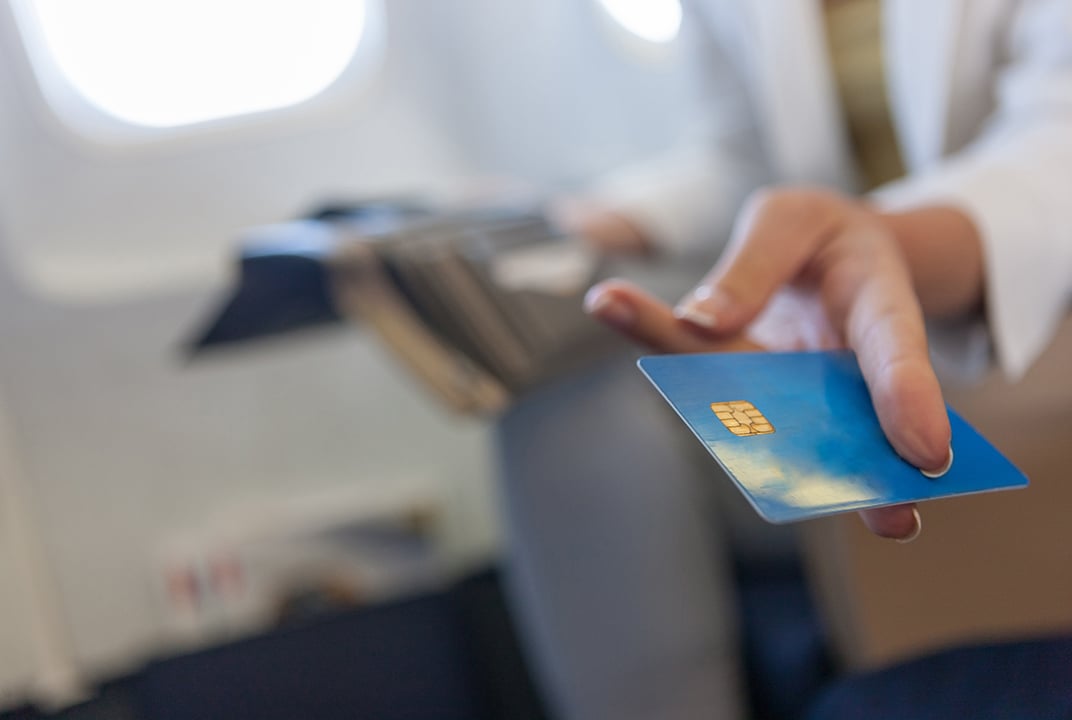Insight | Free is the magic number
Free is the magic number
Aviation
Faced with passenger take-up rates of less than 10%, some airlines are asking what can help the inflight connectivity revolution truly take off. Is the simple answer to make it free at the point of service?
Before he leaves his hotel to get a cab to Heathrow, Andrew checks the weather in New York. Noticing it’s colder than usual, he resolves to buy a jacket online while on the plane and get it delivered to his Manhattan hotel. During an hour-long cab journey, he watches the closing stages of the Champions League semi-final. His team win. He’s very happy.
After speeding through boarding thanks to facial recognition technology – and buoyed by his team’s victory – he sends an email to friends from the departure lounge confirming he’ll book match tickets, flights and a hotel for the final.
Unfortunately, once comfortable in seat 23A, his online journey halts. After a seamless transition from hotel to taxi to airport, his Wi-Fi connection has stopped and it won’t resume until he’s logged on to the airline’s system, come up a username and password and entered his card details. After paying to get connected, he tries to buy a ticket but the slow payment process means he’s too late. All tickets are gone. He’s missed out, because he had to pay for his inflight broadband.
Today, inflight connectivity (IFC) stands at a crossroads. Approximately a third of airlines across the globe offer some form of IFC – with another third committed to offering access in the near future. And yet, despite installing Wi-Fi solutions on their aircraft, take-up rates (TUR) are still low – under 10% in some cases.
For many aviation analysts, this is puzzling. The argument for the transformative potential of inflight broadband has already been won. So why aren’t passengers using it? Quite simply, because some feel it’s too expensive.
Download the report
Expectation versus reality
In almost every part of daily life people can access free public Wi-Fi. It’s available in cafes, restaurants, shopping centres, supermarkets, hotels. And yet, when it comes to boarding a plane, this super-connected, always-on lifestyle just stops, prompting the CEO of Delta Airlines, Ed Bastian to remark: “I don’t know of anywhere besides in an airplane that you can’t get free Wi-Fi.”
Clearly, TURs of less than 10% aren’t encouraging for airline executives that have invested significantly on installing IFC systems, but this isn’t the result of public indifference. Today’s passengers demand inflight broadband. In Inmarsat’s Inflight Connectivity Passenger Survey, 66% of respondents who believed Wi-Fi was fundamental to daily life, said IFC was a necessity.
This demand for a frictionless inflight digital experience is even more pronounced when it comes to younger flyers – millennials and Generation Z. Of those surveyed in the 18-30 range, 91% said they would use inflight Wi-Fi if it was available on their next flight.
“Millennials and younger generations expect free Wi-Fi access everywhere, especially when they are travelling,” said travel trends expert Kelly Soderlund, when speaking to CNBC last year.
“Much like hotels, which have been successful in leveraging consumer loyalty through free Wi-Fi, I would expect airlines to follow suit and meet that demand.”
When airlines begin to offer free access to seamless, consistent, high-speed IFC, industry analysts have noted that TURs shoot up to between 30-40%. Just like every other aspect of their lives, passengers will use inflight broadband if access is simple (no laborious log-in processes) and, crucially, free.
Air New Zealand is one of the industry’s biggest advocates of free inflight broadband. Since rolling out its GX Aviation-powered, free-of-charge model in December 2018, the airline has recorded one million free broadband sessions – with one flight recording an impressive 60% TUR.
In an age where brand differentiation, passenger experience and subsequently, their loyalty, matter more than ever, the benefits of offering free Wi-Fi are compelling. Chris Rogerson, Inmarsat Aviation’s Regional VP for Asia Pacific, believes that Air New Zealand’s model is “a prime example of how this leading airline seeks to delight and surprise its passengers.”
Norwegian is another airline to notch some impressive TURs by utilising a free access model. It recently recorded one million uses of our partner Collins Aerospace’s CabinConnect IFC solution, which is powered by our GX Aviation service.
Alongside passenger benefits, the value to airlines of engaging with connected passengers far outweigh the costs associated with providing free access. It’s commonly accepted that airline passengers are in a spending mindset and these captive customers are happy to exchange their data (often referred to as the oil of the 21st Century) for free access.
And as the installations continue – it’s estimated the number of enabled aircraft will boom over the next few years from 9,000 in 2018 to 23,000 by 2027 – simply offering Wi-Fi will no longer be a service differentiator, says Niels Steenstrup, Vice President, Inmarsat Aviation.
“Airlines will need to use it in a way that sets them apart,” Steenstrup argues. “For this reason, in the near future we expect more airlines to seek out ways to make it free and offset the cost in other ways.”
Who pays?
Of course, someone, somewhere has to pay. The good news for airlines, however, is that passenger data is a very attractive proposition for advertisers, sponsors and airlines.
Steenstrup believes air travel offers advertisers and sponsors a unique opportunity to target a truly ‘captive’ audience.
“An airline could work with a single sponsor to offset the cost, or it could use enhanced data generation to allow advertisers to personalise offers inflight,” he explains. “Ads can be tailored from seat to seat based on a particular flight route, a passenger’s past preferences or purchasing behaviour.”
Additionally, as airtime costs have reduced, mobile network operators have become swayed by the proposition of taking their offers to the sky. Inmarsat works with mobile network operators and sponsors to make Wi-Fi free and help generate a positive ROI for all parties
In a post on Medium, David Fox, Deutsche Telekom’s VP of Infight & Connectivity Services explained why DT has begun including IFC as part of its subscriber offer, either bundled-in or as a flat-rate option, and the answer again was simple – value for its customers.
“Bundling inflight internet adds a lot of perceived value to an MNO’s product portfolio as a whole,” he said.
Inmarsat is also pioneering a new Wi-Fi roaming technology. Passpoint gives passengers seamless roaming access on board, similar to what they’d experience through regular terrestrial roaming services.
As well as sponsored access – American Airline’s tie-in with Apple Music for example – that allows for direct targeting and engagement, airlines are using free IFC as a differentiator. It’s a model that airlines such as Air New Zealand and Norwegian have successfully adopted and one which chimes with the findings of Inmarsat’s passenger survey. 67% of those surveyed said they would be more likely to rebook with an airline if inflight broadband were available.
Passenger experience is king
If an airline can enhance a customer’s journey, this leads to a critical competitive advantage. The possibilities afforded by inflight broadband can act as a brand differentiator.
There are many ways in which IFC can deliver this. These include enabling passengers to stay connected via email, messaging and social media, as well as providing a better inflight entertainment service. Unlocking the potential of ancillary revenue streams (a market that the London School of Economics (LSE)’s first Sky High Economics report, published in association with Inmarsat, predicted to be worth $130bn by 2035) and ecommerce is another broadband-enabled boon. Food and drink can be ordered via passengers’ personal handsets – thus cutting down on waiting time. All things that lead to a better user experience.
Personalisation is also key. As airlines begin to understand their passengers’ better, thanks to the data accrued, they can offer their customers a more relevant, tailored service. This in turn becomes a virtuous circle.
And let’s not forget the operational efficiencies and savings high-quality IFC can roll out too.
The higher conversion rates afforded by free access to inflight broadband is also fundamental. TURs over 40% are beneficial to advertisers and airline affiliate partners (credit card providers, car rentals, tour operators). Their funding creates a platform that passengers want to engage with – free of charge – which in turn enhances their journey.
The new generation
For airlines looking to embrace the world of possibilities offered by inflight broadband, the time to act is now. Generation Z and millennial digital natives have different expectations of air travel and technology, and the airlines that best accommodate their demands will win out.
As Sky High Economics 3 highlighted, these airlines will also be best placed to win an annual $33bn market – and increasing – by offering the kind of connected inflight experiences that this new breed of passenger wants.
And what this passenger wants is instant and automated access to inflight broadband. Offering a consistent, seamless and high-speed broadband service is only the start. For those desirable TURs of 30-40%, the access has to be free. And for proof that this isn’t a leap into the unknown, just look at the success achieved by Air New Zealand and Norwegian.
And keep our disgruntled flyer Andrew in mind. Because the airline that offers him frictionless access is the one that’ll be front-of-mind next time he looks to book a flight.


